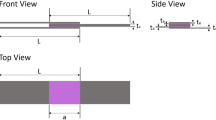Abstract
A study into the vibration characteristics of adhesively bonded single-lap joints has been carried out to investigate the effect of joint geometry and temperature variation on overall system damping. Concepts of vibration damping are introduced, and it is shown how to determine the damping of a system. The methodology of calculating the damping of even a simple bonded element in the form of a lap joint from material and geometric parameters is shown to be complex. The vibration damping of bonded joints has been extended into an experimental program using four different adhesives. These were AV119, a one-part epoxy; 9245, a structural bonding tape; 3532, a two-part polyurethane; and Hysol XEA 9359.3, a two-part structural adhesive. High-strength steel adherends were used to manufacture single-lap joints of varying overlap lengths. The specimens were vibrated flexurally and the damping values calculated using the free decay method. In this investigation, the damping of the adhesive layer dominates the damping of the specimens rather than the damping of the adherends. An optimum overlap ratio was found at approximately 0.25 in this study. The adhesives were tested under varying temperature conditions to illustrate the dominance of the glass transition temperature on the damping of the specimen.
It has been shown that the damping of a structure is unlikely to be improved by using adhesive bonding as a joining method.
Similar content being viewed by others
References
Adams RD (1972a) Damping of ferromagnetic materials at direct stress levels below the fatigue limit. J Phys D Appl Phys 5:1877–1889
Adams RD (1972b) The damping characteristics of certain steels, cast irons and other metals. J Sound Vib 23:199–216
Adams RD, Bacon DGC (1973) Measurement of the flexural damping capacity and dynamic Young’s modulus of metals and reinforced plastics. J Phys D Appl Phys 6:27–41
Adams RD, Fox MAO (1972) Measurement of the damping capacity and dynamic modulus of high-damping metals under direct cyclic stress. J Phys D Appl Phys 5:1274–1283
Adams RD, Lloyd DH (1975) Apparatus for measuring the torsional modulus and damping of single carbon fibres. J Phys E: Sci Instrum 8:475–480
Adams RD, Percival AL (1969) Measurement of the strain-dependent damping of metals in axial vibration. J Phys D Appl Phys 2:1693–1704
Adams RD, Singh MM (1995) The effect of immersion in sea water on the dynamic properties of fibre-reinforced flexibilised epoxy composites. Compos Struct 31:119–127
Adams RD, Comyn J, Wake WC (1997) Structural adhesive joints in engineering. Chapman & Hall, London
Brearley T, Nehammer E, Rouse E, Vaughn D (2005) An investigation into damping in structures. Internal report. University of Bristol
Den Hartog JP (2008) Mechanical vibrations. Maple Press, York
Guild FJ, Adams RD (1981) A new technique for the measurement of the specific damping capacity of beams in flexure. J Phys E Sci Instrum 14:355–363
He S, Rao MD (1992a) Vibration analysis of adhesively bonded lap joint, part I: theory. J Sound Vib 152:405–416
He S, Rao MD (1992b) Vibration analysis of adhesively bonded lap joint, part II: numerical solution. J Sound Vib 152:417–425
Hildebrand M, Vessonen I (1997) Experimental data on damping of adhesively bonded single-lap joints. VTT Manufacturing Technology, Finland
Kadioglu F (2000) Quasi-static and dynamic behaviour of a structural pressure sensitive adhesive. PhD thesis, University of Bristol, Bristol
Lin DX, Ni RG, Adams RD (1984) Prediction and measurement of the vibrational damping parameters of carbon and glass fibre-reinforced plastics plates. J Compos Mater 18:132–152
Maheri MR, Adams RD, Hugon J (2008) Vibration damping in sandwich panels. J Mater Sci 43:6604–6618
Mead DJ (1998) Passive vibration control. Wiley, Chichester
Nashif AD, Jones DIG, Henderson JG (1985) Vibration damping. Wiley Interscience, New York
Park T-H (1996) Vibration and damping characteristics of a beam with a partially sandwiched viscoelastic layer. J Adhes 61:97–122
Saito H, Tani H (1984) Vibrations of bonded beams with a single-lap adhesive joint. J Sound Vib 92:299–309
Author information
Authors and Affiliations
Corresponding author
Editor information
Editors and Affiliations
Appendix
Appendix
1.1 Damping Measurement by the Free Decay Method
This is a relatively simple method of measuring the damping of a freely vibrating system. The logarithmic decrement (log dec.), Δ, is measured from an amplitude-time graph and is based on measuring the rate of decay of the free vibrations. This method is only suitable for measuring low damping and free vibration.
During the experiment, readings are recorded by measuring the time taken for the amplitude of the waveform to decrease from A1 to A2 (Fig. 16).
The relationship between log dec. and the damping ratio can be found by consideration of the equation for damped oscillation:
The log dec. is defined by
Noting that \( {\tau}_d=\frac{2\pi}{w_d}=\frac{2\pi}{w\sqrt{1-{\zeta}^2}} \)
Therefore \( \Delta =\frac{2\pi w\zeta}{w\sqrt{1-{\zeta}^2}} \)
And so if the damping ratio is small, ζ → 0 and so
A more accurate result can be obtained by considering the decay over a number of peaks. The log dec. is then
where N is the number of peaks calculated using the formula ft = N, where f is the frequency of oscillation, and t is the time taken for the amplitude to decay from A1 to A2.
Rights and permissions
Copyright information
© 2017 Springer International Publishing AG
About this entry
Cite this entry
Adams, R.D., Cooper, D.G.A., Pearson, S. (2017). Vibration Damping of Adhesively Bonded Joints. In: da Silva, L., Öchsner, A., Adams, R. (eds) Handbook of Adhesion Technology. Springer, Cham. https://doi.org/10.1007/978-3-319-42087-5_30-2
Download citation
DOI: https://doi.org/10.1007/978-3-319-42087-5_30-2
Received:
Accepted:
Published:
Publisher Name: Springer, Cham
Print ISBN: 978-3-319-42087-5
Online ISBN: 978-3-319-42087-5
eBook Packages: Springer Reference EngineeringReference Module Computer Science and Engineering





